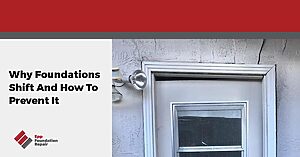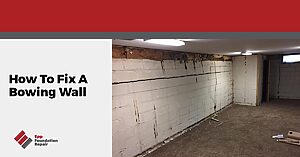Stem wall foundations are among the most popular foundations because of their strength and adaptability. However, they are not without fault. Learn about the pros and cons of stem wall foundations, how to keep your stem wall in good condition, and what you can do to repair a damaged one.
What Is a Stem Wall?
When you hear the word “stem,” your first thought is likely a flower stem. Well, what does a flower stem do? It connects a plant’s root system to its leaves and flowers and helps support the whole plant. Similarly, a stem wall is a raised foundational structure that connects a structure’s external walls to the concrete footings in the ground.
Stem walls are short, partially submerged foundational walls up to one foot wide and around three feet tall, forming a continuous building perimeter. About a third of the wall is submerged below the ground and connects to concrete footers, while the top is connected to the building’s exterior walls and potentially a concrete slab. Stem walls are usually constructed using concrete blocks, poured concrete, or precast concrete panels. The walls are reinforced with steel rods in each case to provide additional stability.

What Is the Difference Between a Stem Wall Foundation and a Monolithic Slab Foundation?
A monolithic slab foundation is one solid foundation, about four to six inches thick, with built-in footings, poured directly on the prepared soil. They are a popular foundation option because of their ease of construction and minimal maintenance needs.
Unlike stem wall foundations, though, monolithic slabs must be built on level land and are unsuitable for areas prone to flooding or the freeze-thaw cycle. Monolithic slabs also make accessing plumbing and electrical hookups below the home harder because they are covered by a solid cement slab, often requiring jackhammering to reach them. Some municipalities also restrict how large you can build a monolithic slab, making it an inaccessible option for some homeowners.
What Are the Pros and Cons of Stem Walls?
Stem wall foundations are desirable for structural and even aesthetic purposes, but they also present particular challenges worthy of consideration.
Advantages of a Stem Wall Foundation
- Suitable for Various Terrains
Stem walls do not require entirely level ground, making them ideal for different property types, including sloped ones. Stem walls can accommodate the ground’s varying heights to ensure your home has a level floor. - Safer in Flood Zones
Stem wall foundations are ideal for areas prone to flooding because they elevate a structure above the soil, keeping the building safe from water damage. - Aesthetics
Do you like the look of an elevated home? Imagine your dream home with a porch and steps. A stem wall foundation can provide a house with such an elevated look. - Easy Access
A stem wall creates space between the home and the earth, making accessing any electrical or plumbing hookups below the ground easier.

Disadvantages of a Stem Wall Foundation
- Longer and Harder to Build
Building a stem wall foundation takes more time and skill than other foundation options, like a monolithic slab. This can make stem wall foundations more expensive to build in some cases. - More Maintenance
Compared to a monolithic slab, the stem wall foundation’s elevated nature requires more maintenance to avoid issues like infestation, water damage, and cracks.
What Common Problems Do Stem Wall Foundations Have?
Stem walls, although being an extremely sturdy foundation option, are not indestructible. Here are some common problems you may encounter:
Soil Movement
If the soil was not adequately prepared before construction, the soil below your foundation could erode, shift, and settle, risking the integrity of your foundation. As a result, you may experience cracks in the foundation and uneven settling of your home.Cracks
Cracks can happen in any type of foundation. If left unattended, cracks can lead to problems like water damage, infestations, and even structural instability.Exposed Rebar
When the rebar is exposed to moisture, it can corrode, even within the concrete. Over time, the corroded rebar will damage the surrounding concrete and cause it to break apart.Concrete Spalling
Also called cement rot, concrete spalling is concrete deterioration due to natural or chemical reactions. Spalling concrete will have a pitted, flakey, chipped, or fractured appearance.

How Should You Maintain Your Stem Wall Foundation?
To prevent costly repairs down the road, it is always best to take precautionary measures to protect your stem wall foundation. Try these steps:
Regular Inspection
Once a month, take a moment to walk around your home and check the foundation for any signs of cracking or spalling. If you see a potentially damaged area, take note of it and monitor the area more often for any changes.Proper Water Drainage
Water is detrimental to your home’s foundation, so do your utmost to keep it away. Preventative measures can include using downspout extensions, ensuring that your gutters are diverting rainwater away from your foundation and your yard is sloping away from your home to minimize the effects of groundwater. You may even look into building trenches or drainage systems to avoid water accumulation near your home.Call a Professional
If you are ever in doubt about the significance of any potential damage to your foundation, seek professional advice.
How Do You Repair a Damaged Stem Wall Foundation?
If your stem wall foundation requires repairs, there are a variety of solutions.
Wall Repair
If your wall is cracked or crumbling, there are multiple tools to help. There is always a solution, from epoxy injections to carbon fiber wall straps. In some instances, though, concrete and rebar replacement is the best option. An expert can help you determine what your home needs.Foundation Underpinning
If your home is settling unevenly, push piers or helical piers can permanently stabilize the foundation. These piers are quick to install and are minimally invasive.
Of course, every situation is different, and the solution relies on addressing the problem’s unique source and the severity of the damage. Contact us for a thorough home assessment; an expert can create a quote with your needs in mind.







